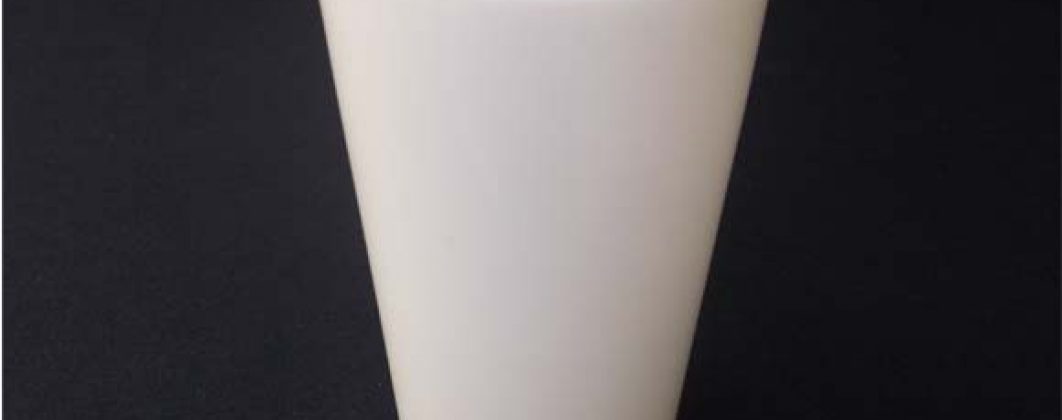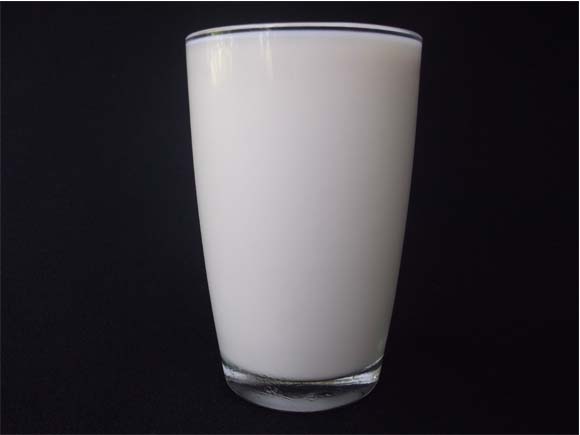

The primitive man drank his water from the flowing rivers and water tanks by cupping his hands to form a tumbler to drink. Later, he started using leaves by rolling them like a tumbler. Subsequently, with the invention of the cutting tool, he started using the hollow bamboo cut to size to form a tumbler. With progress of civilization, he started making earthen pots to store water and small pots to drink water. With the invention of metals like copper and brass, he started making tumblers with these metals to drink and carry water. Next, with the invention of glass blowing technique, man started making different varieties of tumblers with glass material not only for drinking water but also for the purpose of drinking wine, fruit juices, milk and other liquid foods.
The civilized man invented a special variety of glass for decorative and aesthetic appeal and one such variety of glass is known as milk glass. I am fortunate enough to collect one drinking tumbler made out of milk glass. I am happy to introduce this beautiful vintage milk glass tumbler to you and I hope you will admire its bewitching beauty as much as I do.





The Story of the Milk-glass Tumbler
This beautiful milk glass tumbler was purchased by my father in the year 1930. Yanam is a French colony which is around 40 kilometers from our village Someswaram in East Godavari district of present Andhra Pradesh. The rest of Andhra Pradesh used to be under British rule. In order to expand their business, the French people in India used to import lot of goods into Yanam and sell them in the rest of the British India. Many women street vendors used to smuggle interesting items into nearby villages in cane baskets carrying them on their head. Such street vendors used to come to our village also and my father purchased this French made milk glass tumbler from such vendors. In those days, there were no shopping malls to purchase the items you want. You had to purchase items that are available to you. Otherwise you had to buy the similar British goods from the shops in cities like Madras (present Chennai), Bombay (Present Mumbai) or from Calcutta (present Kolkata) or Delhi.
This precious milk glass tumbler used to be kept is a locked cup board in our house. Whenever important guests came home, we used to take out the glass from the cupboard and serve cool water in this glass. We also had coconut trees in our house. In summer, we used to drink tender coconut water from this glass which used to be a very pleasant experience. It used to be a wonder in our village to have glass like this. When our family shifted from our village owing to the job I took up, this particular glass was carried by my mother in her suitcase along with her clothes for safe transportation. Subsequently, I have shifted into around 50 houses on my various assignments, and every time my mother used to take charge of this delicate glass for safe transportation to our new locations. Finally, we settled in Hyderabad since the last 15 years and now this glass is the part of my collection at Hyderabad.
This charming vintage milk glass tumbler is 5 inches tall,3 inches in diameter at the rim and 2 inches in diameter at the bottom.
We have another important event connected to Yanam. My mother and father got married in Yanam. In those days, it was a tradition and social norm to marry the girls before they attained puberty. The average age for a girl to attain puberty is around 13 years and they had to be married before turning 13. But this was against the law in those days. In British India, there used to be a law called “Sarada Act” which stated that girls should be married only after they attain the age of 18 years. Getting the girls married before they turned 18 was punishable under the law. The “Sarada Act” was against the social custom and the parents of the girls used to escape this law by celebrating the girl’s marriage in Yanam which was under French law and British “Sarada Act” was not applicable there. My maternal grandfather, in his orthodox approach, celebrated my mother’s marriage before she turned 12 at Yanam.
The HistoryOf Glass
Glass was known to Stone Age man as early as 9,000 years who made tools such as cutting tools and spear heads with natural glass. Archaeologists have found that since 3,500 BC in the Bronze Age, ancient civilizations like Mesopotamia and Egypt were using man-made glass for coating stone beads for decorative purpose. The first hollow glass resembling a tumbler was made in 1500 BC by covering a layer of molten glass on a sand base model.
The major breakthrough happened in glass making with the invention of glass blowing around 1st century BC in Babylon. Glass manufacturing and usage has taken interesting strides throughout human civilization, particularly influenced by cultures of China, Africa and Europe.
How natural glass is formed?
Natural glass is formed when natural events that produce super high degree of temperature melt certain kinds of rocks to form a sheet of liquid glass.When the liquid glass is cooled down, a hard sheet of glass is formed. During volcanic eruption when hot lava (liquid rock) is flown into cool water beds like tanks or rivers, a shiny black natural glass is formed. Similarly, when lightning strikes on earth or a meteorite collides with earth, super high temperatures are generated due to high impact. Such high temperatures melt certain varieties of rocks that produce natural glass.
Characteristics of Glass
Glass material is inorganic and solid in nature, clear or translucent.It is brittle and can withstand sun, rain and wind. Glass is utilized for making utensils, windows, bottles and mirrors and other kinds of items.
Discovery of Man-made Glass
Man has discovered a strange stone which we call now as glass in the ashes of a fire thousands of years before. This might have happened by accident. The Roman historian Pliny wrote in A.D. 77 that Phoenician sailors placed “stones of soda ash” into a fire (presumably to rest their posts on) on a sandy beach. They later found a “hard smooth stone” in the ashes. That’s one possible scenario, given that sand, soda ash (sodium carbonate), and heat are all ingredients for making glass.

What is milk glass?
Milk glass got its name from its milky white color.Milk glass is a translucent or opaque glass with milky color that can be pressed or blown into a variety of shapes. These varieties include decorative lamps, drinking glasses, dinnerware, costume jewelry and vases .The articles made with milk glass are known for their beauty and grace in design. Milk glass items were first made in the 16th century in Venice .These can also be made in colors like yellow, blue, brown, black and pink. Out of all these colors, the white milky color is the most popular. The milk glass is originally called “opal glass” because it is opaque in nature. In the later years, it came to be called as milk glass basing on its white milky color. To get this beautiful opaque milky white color, opacifiers like bone ash or tin dioxide are added to the regular glass. These milk glass items make a wonderful collection items.World over, the lovers of milk glass collect original antiques or replicas of popular collectable items.

Copyright © 2021 YK Antiques Home Museum